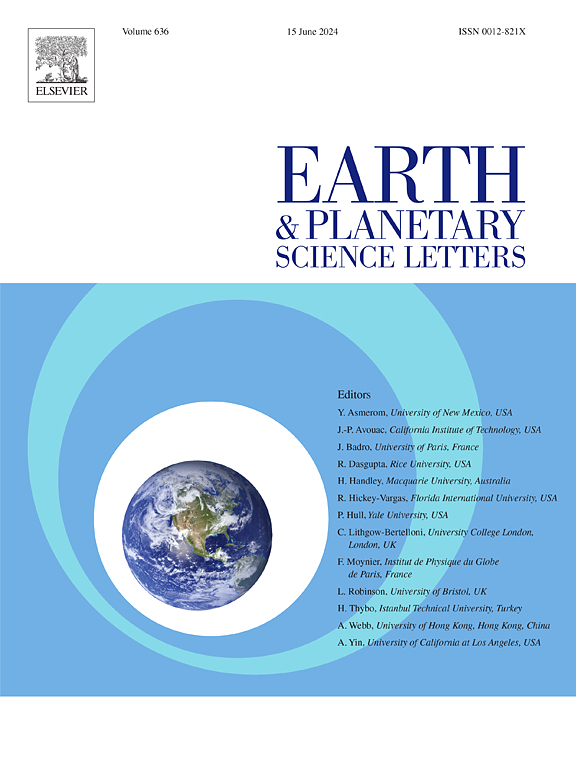Intraoceanic active rifting revealed by deep seismic reflection imaging in the southern Bay of Bengal, northeastern Indian Ocean
IF 4.8
1区 地球科学
Q1 GEOCHEMISTRY & GEOPHYSICS
引用次数: 0
Abstract
Oceanic domains form via the break-up of the continental lithosphere resulting from extensional tectonic processes that eventually create passive margins. Whether active rifting and subsequent volcanic break-up occur within the oceanic lithosphere remains ambiguous. New seismic reflection data from the southern Bay of Bengal, where multiple mantle plumes were active during the late Cretaceous, provide visual evidence for resolving this issue. The studied seismic profile reveals an ∼300-km-wide anomalous crustal domain characterized by basement highs, irregular Moho depth fluctuations, and a thick pile of well-organized upper crustal dipping reflections. These features resemble those of volcanic passive margins, i.e., stacked volcanoclastic layers, seaward-dipping reflectors, underplating and failed rifting centers. Here, we document a similar setting within an intraoceanic domain, which is consistent with the active rifting model, with an excess magma supply presumably associated with active mantle upwelling. The structures described in the present study require a multistage dynamic process during local impingement of the northward-drifting Indian oceanic lithosphere by mantle upwelling, with a transition from thermal doming, intense volcanic eruptions and magmatic underplating, to lithospheric extension and necking, and finally to an incipient but failed rift. The volcanism initiated at ∼84–85 Ma, and volcanics were emplaced on young oceanic lithosphere with an age of ∼7–8 Ma. The active mantle upwelling that promoted the intraoceanic rifting was likely driven by a weak or pulsed branch of the Kerguelen Plume, which is also involved in producing the Ninety-East Ridge. These findings help further understand the processes dominating lithospheric breakup and extend some concepts seaward from passive margins to the interior of the oceanic lithospheric domain.
印度洋东北部孟加拉湾南部深地震反射成像揭示的洋内活动裂陷
洋域的形成是由伸展构造过程导致的大陆岩石圈的破裂,最终形成被动边缘。是否在海洋岩石圈内发生了活跃的裂谷作用和随后的火山破裂仍然不清楚。来自孟加拉湾南部的新地震反射数据,在白垩纪晚期有多个地幔柱活跃,为解决这个问题提供了直观的证据。研究的地震剖面显示了一个宽约300 km的异常地壳域,其特征是基底高、不规则的莫霍深度波动和一堆组织良好的上地壳倾斜反射。这些特征类似于火山被动边缘,即堆积的火山碎屑层、向海倾斜的反射层、底板和破碎的裂陷中心。在这里,我们记录了一个类似的洋内域环境,这与活动裂谷模型相一致,过量的岩浆供应可能与活跃的地幔上涌有关。本研究所描述的构造需要地幔上升流对北漂的印度洋岩石圈局部冲击的多阶段动力学过程,从热穹化、强烈火山喷发和岩浆底沉积到岩石圈伸展和颈缩,最后到一个早期但失败的裂谷。火山活动起源于~ 84 ~ 85 Ma,火山位于~ 7 ~ 8 Ma的年轻海洋岩石圈上。促进洋内裂谷的活跃地幔上涌很可能是由凯尔盖伦羽的一个微弱或脉冲分支驱动的,该分支也参与了东九十岭的形成。这些发现有助于进一步理解主导岩石圈破裂的过程,并将一些概念从被动边缘向海扩展到海洋岩石圈域的内部。
本文章由计算机程序翻译,如有差异,请以英文原文为准。
求助全文
约1分钟内获得全文
求助全文
来源期刊

Earth and Planetary Science Letters
地学-地球化学与地球物理
CiteScore
10.30
自引率
5.70%
发文量
475
审稿时长
2.8 months
期刊介绍:
Earth and Planetary Science Letters (EPSL) is a leading journal for researchers across the entire Earth and planetary sciences community. It publishes concise, exciting, high-impact articles ("Letters") of broad interest. Its focus is on physical and chemical processes, the evolution and general properties of the Earth and planets - from their deep interiors to their atmospheres. EPSL also includes a Frontiers section, featuring invited high-profile synthesis articles by leading experts on timely topics to bring cutting-edge research to the wider community.
 求助内容:
求助内容: 应助结果提醒方式:
应助结果提醒方式:


